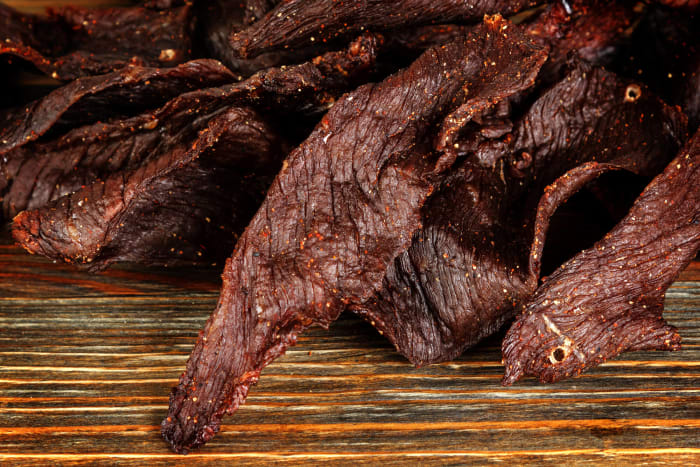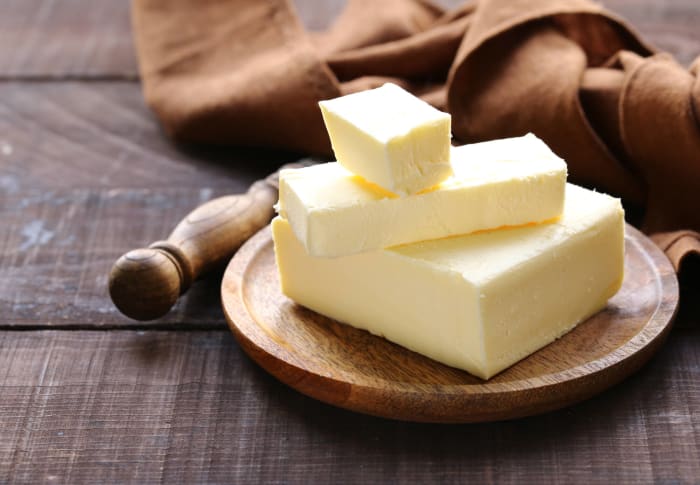There are plenty of foods and drinks currently consumed that are recent inventions—Red Bull, plant-based burgers, the Cronut—while others have existed for hundreds of years or more. In fact, some things we still eat and drink today have been consumed by humans for millennia. (And for the record, we’re not even talking about fruits, vegetables, and other produce you simply pick off a plant or tree.) Here are 21 foods & drinks that have been around for thousands of years.
Boltenkoff / Shutterstock.com
The first written records of modern-day jerky come from the 1550s when Spanish conquistadors spoke of “ch’arki,” a dried form of llama or alpaca meat made by the indigenous people of what is now Peru. However, earlier versions of jerky have been made by Native Americans for thousands of years and there’s also evidence of dried meat found in tombs in Ancient Egypt from the 14th century B.C.E.
Jag_cz / Shutterstock.com
The first evidence of barley beer dates back more than 5,000 years ago in the Middle East, but ceramics suggest it’s possible beer had been brewed in the region for hundreds or thousands of years prior to that. In 2021, archeologists in Southeastern China also discovered the residue of a lightly fermented beer-like beverage made from rice, tubers, and fungi from 9,000 years ago!
Tercer Ojo Photography / Shutterstock.com
Bread—specifically the leavened kind that’s made with yeast—has been baked in Egypt for at least the last 3,000 years. Some researchers date the first use of yeast even farther back, claiming that there’s evidence that sourdough bread was first made 6,000 years ago!
Dream79 / Shutterstock.com
The first known instructions for preparing butter were written on a Sumerian tablet that dates back to 2,500 B.C.E.—but it’s likely butter predates that ancient recipe by several thousand years. Historians believe that 10,000 years ago, herdsmen discovered that milk transported in sheepskin bags would curdle into a tasty, solid form after being jostled for hours on end during long journeys.
Sea Wave / Shutterstock.com
Like butter, cheese was likely invented by accident some 10,000 years ago. The enzyme mixture known as rennet is produced in the stomachs of young mammals, and milk stored in these stomachs led to the creation of the first cheese. Instructions for cheesemaking have survived from Ancient Greece and Ancient Egypt—making them 4,000 years old or more!
beats1 / Shutterstock.com
Not only do we know how long cheesecake has been around, but we might even know who published one of the earliest recipes. Cheesecake was apparently popular all the way back in Ancient Greece, with the Greek physician Aegimus—who lived in the 5th century B.C.E.—writing an entire book on the art of making a dessert similar to the one we know today. A more modern version, as well as the name “cheesecake,” dates back to 14th or 15th century England.
Nina Lishchuk / Shutterstock.com
Cacao has been harvested for nearly 4,000 years in the areas now known as North and Central America, and it was so valuable to the Mayans that cacao beans were once used as currency. The Olmecs—the earliest known major civilization in the area—were known to use cacao to make a chocolate beverage, and there’s even some evidence that chocolate drinks predate the Olmecs!
nelea33 / Shutterstock.com
Curry generally refers to an Indian stew made with a sauce consisting of various spices, so it’s not surprising that evidence suggests this simple dish has been made on the Indian subcontinent for some 4,500 years. That’s a long time, which explains why regional curries now exist in nearly every continent.
Svetlana Monyakova / Shutterstock.com
Researchers in Europe found evidence of grains from cattails and ferns on grindstones and pestle grinders at three sites in Italy, Russia, and the Czech Republic that date back 30,000 years. Evidence of a more modern version of flatbread—made from wild wheat and barley—was also found in Jordan’s Black Desert and was estimated to be some 14,000 years old. Scientists from the latter site speculated the flatbread may have been used to wrap meat, so that find could also be the oldest evidence of sandwiches!
Billion Photos / Shutterstock.com
A rock painting in Valencia, Spain that dates back to 6,000-8,000 B.C.E. depicts a hunter gathering honey from wild bees, confirming that humans have been eating this bee byproduct for at least that long. Even beekeeping has ancient origins, as there are written records of this practice that originate from Egypt circa 2,500 B.C.E.
Tawan Ramtang / Shutterstock.com
In 2005, archaeologists made a historic discovery in northwestern China: A 4,000-year-old bowl of noodles. Historians knew noodles have been around for thousands of years, but this finding provided evidence of an even earlier date. And if you’re wondering about the type of noodle found, it was similar to the wheat flour-based lamian noodles still consumed today.
DUSAN ZIDAR / Shutterstock.com
In Israel, just a mile west of Nazareth, researchers discovered ancient pottery that was found to contain traces of olive oil. Those researchers estimated the age of the pottery to be 8,000 years old! In addition to cooking, olive oil was used for lamp fuel, medicine, soap, religious ceremonies, and even perfume.
Tat2821 / Shutterstock.com
The first recorded mention of pancakes comes from the 5th century B.C.E., when a pair of Ancient Greek poets described tagenites, a food made from wheat flour, oil, honey, and milk. This meal was prepared in a frying pan, called a tagenon, hence the origin of the name tagenites. However, it’s possible pancakes were invented even longer ago…maybe even thousands of years prior, as Otzi the Iceman—a mummified man who lived around 3,200 B.C.E.—had what researchers believe to be pancakes in his stomach.
Suwan Wanawattanawong / Shutterstock.com
The exact time when rice was first cultivated is still up for debate, but it’s generally cited as being about 10,000 years ago, according to archaeological findings. The world has yet to get sick of this seed—much to the contrary, as about half of the world’s population, eats rice every day.
Madeleine Steinbach / Shutterstock.com
Although it’s most associated with German cuisine, sauerkraut, like many other foods, likely originated in China. Laborers who built the Great Wall of China 2,000 years ago subsisted on cabbage and rice, and would use rice wine to preserve the former during the non-growing season, resulting in its fermentation.
Madeleine Steinbach / Shutterstock.com
Man discovered fire about 400,000 years ago, but soup isn’t quite that old—at least according to the evidence found thus far. In 2013, archaeologists from Harvard discovered 22,000-year-old pottery in a cave in China that featured scorch marks, suggesting it was heated over a fire. Although it’s possible something other than soup was cooked in the bowls, it’s highly likely that broth or stock was regularly consumed by our ancient ancestors in an effort to render fat from animal bones and avoid protein poisoning.
Malochka Mikalai / Shutterstock.com
Soy sauce is a popular condiment in Asian cuisine, and it has had plenty of time to build up a following. Historians say early versions of this salty sauce were first invented in China 2,200 years ago during the Han Dynasty and were used to preserve meat, vegetables, and grains.
Marcos Castillo / Shutterstock.com
While the folks in Asia were cultivating rice, people in what is now Mexico and Guatemala were making tamales. That’s right, the tamale might date back as far as 10,000 years! As this meat, cheese, and/or bean-filled food is wrapped in dough inside a corn husk or banana leaf, it was the perfect portable meal for hunters and warriors alike.
iprachenko / Shutterstock.com
Prince Liú Ān ruled during China’s Han Dynasty more than 2,000 years ago. The scholar is credited with editing and publishing numerous pieces of classic Daoist literature, but also for inventing tofu! Whether he personally invented bean curd is still up for debate, but this timeframe for tofu’s invention is generally agreed upon.
Ievgenii Meyer / Shutterstock.com
The earliest evidence of wine dates back 8,000 years ago via earthenware jars containing residual wine compounds that were found in two different sites near the Georgian capital of Tbilisi in 2007. And in case it wasn’t clear from the substance in the jars, the exteriors of some of the vino vessels were adorned with grape clusters and a person dancing. That’s something we have in common with our ancient ancestors: Wine makes us want to dance, too.
Nazile Keskin / Shutterstock.com
Historians believe yogurt was first invented—likely when milk was accidentally fermented—around 5,000 B.C.E, after the domestication of milk-producing animals in Central and Western Asia. Since then, it has become a staple of diets around the world, especially in Turkish culture, which gave the food its name!

 +
+





























